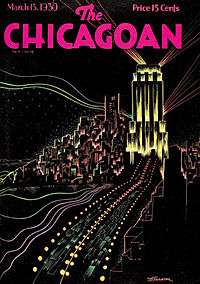The Chicagoan
|
Cover of the Chicagoan magazine, March 15, 1930. | |
| Categories | Politics, social issues, popular culture |
|---|---|
| Frequency | Twice monthly from June 1926 until July 1931; Monthly from July 1931 until April 1935 |
| Publisher | Martin J. Quigley |
| Paid circulation | Upwards of 20,00 at its peak |
| First issue | June 14, 1926 |
| Final issue | April 1935 |
| Country | United States |
| Based in | Chicago |
| Language | English |
The Chicagoan was an American magazine modeled after the New Yorker published from June 1926 until April 1935. Focusing on the cultural life of the city of Chicago, each issue of the Chicagoan contained art, music, and drama reviews, profiles of personalities and institutions, commentaries on the local scene, and editorials, along with cartoons and original art.
In an early issue, the Chicagoan's editors claimed to represent "a cultural, civilized and vibrant" city "which needs make no obeisance to Park Avenue, Mayfair, or the Champs Elysees." Despite its lofty aims, the stalwart assertions of publisher Martin J. Quigley (who once wrote that "Whatever Chicago was and was to be, the Chicagoan must be and become"), and a circulation that sometimes rose above 20,000, the magazine was largely forgotten after its last issue.[1]
Only two substantial collections remain, one at the University of Chicago's Regenstein Library and the other at the New York Public Library. Cultural historian Neil Harris has recently written a book on the subject, The Chicagoan: A Lost History of the Jazz Age (the University of Chicago Press).
Authors
Marie Armstrong Hecht (1892-?). First editor of the Chicagoan, a writer and literary critic. Married to journalist-author Ben Hecht from 1915 to 1925. Marie Hecht published several volumes of poetry in the 1920s and created or adapted some Broadway plays in the 1920s and 1930s. Under a later married name, Marie Essipoff, she produced a number of books in the 1950s emphasizing economical cooking with new techniques, including Making the Most of Your Food Freezer.[2]
Richard Atwater, "Riq" (1892–1948). Born in Chicago as Frederick Mund Atwater, he attended the University of Chicago, where he wrote for the student newspaper and later taught Classical Greek. He went on to work for various local newspapers, including the Chicago Daily News, the Chicago Tribune, and the Herald-Examiner. With his wife, Florence Atwater, in 1938 he coauthored Mr. Popper's Penguins, which won the Newbery Medal.[3]
Artists
E. Simms Campbell (1908–71). The first African American cartoonist with a national reputation, Campbell was born in St. Louis and graduated from Englewood High School in Chicago. He attended the School of the Art Institute of Chicago between 1924 and 1926 and later he moved to New York, where he was employed as a cartoonist at the Daily Mirror. He did important illustrations for some African American publications, like Crisis and Opportunity, but was better known for his color cartoons in Esquire. He would later work for a string of national advertisers and for Playboy.[4]
Albert Carreno (1905–64). This Mexican-born caricaturist and cartoonist portrayed stage and sports personalities for the Chicagoan in the late 1920s while working for the Chicago Daily News. He then moved to New York and was employed by a series of publishers and comic-book producers including Fawcett, National, and Marvel.[5]
Nat Karson (1908–54). Born in Switzerland, he attended Chicago public schools and the School of the Art Institute of Chicago and increasingly concentrated his efforts on theatrical caricature. After he moved to New York, his theatrical designs and productions attracted wide attention; he created both sets and costumes with the Federal Theater Project and with Orson Welles.[6]
A. Raymond Katz (1895–1974), aka Sandor. Born in Hungary, Katz attended both the School of the Art Institute of Chicago and the Chicago Academy of Fine Arts. He created car cards, posters, and other commercial art before becoming the featured artist of the Chicagoan.[7]
Isadore Klein (1897–1986). Magazine cartoonist, animator, sketcher, painter, and story writer, Klein worked for the New Yorker as well as for the Chicagoan and was involved with a series of famous studios and celebrated cartoons, from Krazy Kat and Betty Boop to Popeye. He was widely credited with originating the idea for Mighty Mouse.[8]
Boris Riedel (no dates available). Creator of the Chicagoan's first cover, Riedel served for a while as the magazine's art editor. He illustrated a book of poetry by Marie Hecht, a novel by J. V. Nicholson, and a children's book, The Timid Giant, written by advertising executive Earle Ludgin. Riedel also created movie posters for films starring Clara Bow, Lon Chaney, Sr., and Adolphe Menjou and contributed to The Linebook, a publication put out for WGN Radio, a Tribune Company outlet in Chicago.[9]
Resurrection
J.C. Gabel, former publisher of Stop Smiling, has acquired the rights to the magazine and plans to launch the restored magazine in September, 2011 as a biannual publication with weekly Website updates.[10] Jessa Crispin has signed on as a contributor and fiction editor.[11]
References
External links
- Digitized version of The Chicagoan at the University of Chicago Library
- Gallery of covers and other illustrations from the Chicagoan
- Sample pages from The Chicagoan:A Lost Magazine of the Jazz Age by Neil Harris
- An interview with Neil Harris about the Chicagoan
| ||||||||||||||||||||||||||||||||||||||||||||||||||||||||||||||||||||||||||||||||||||||||||
